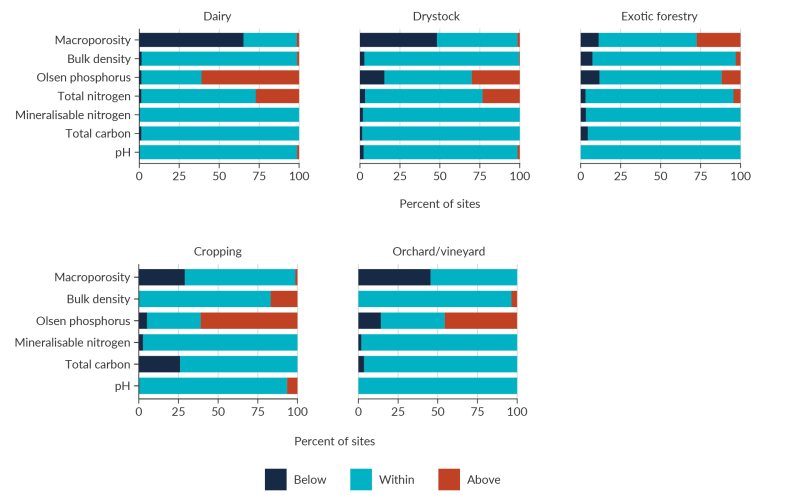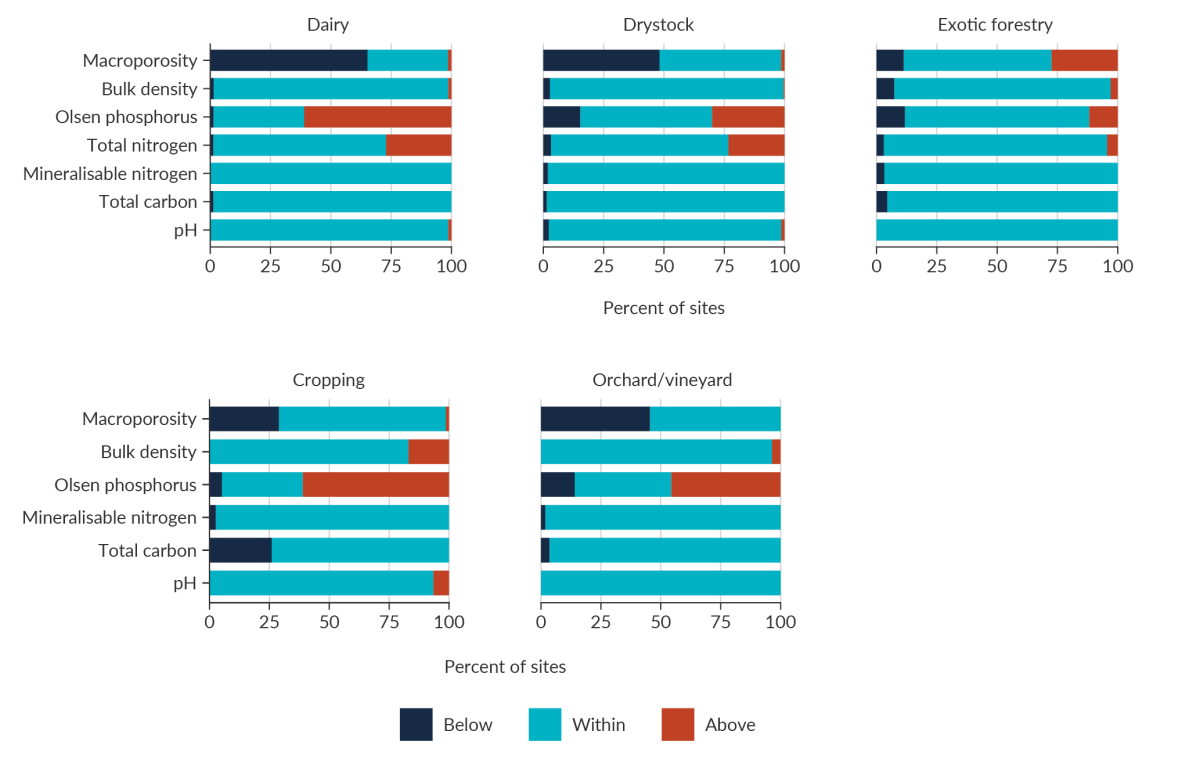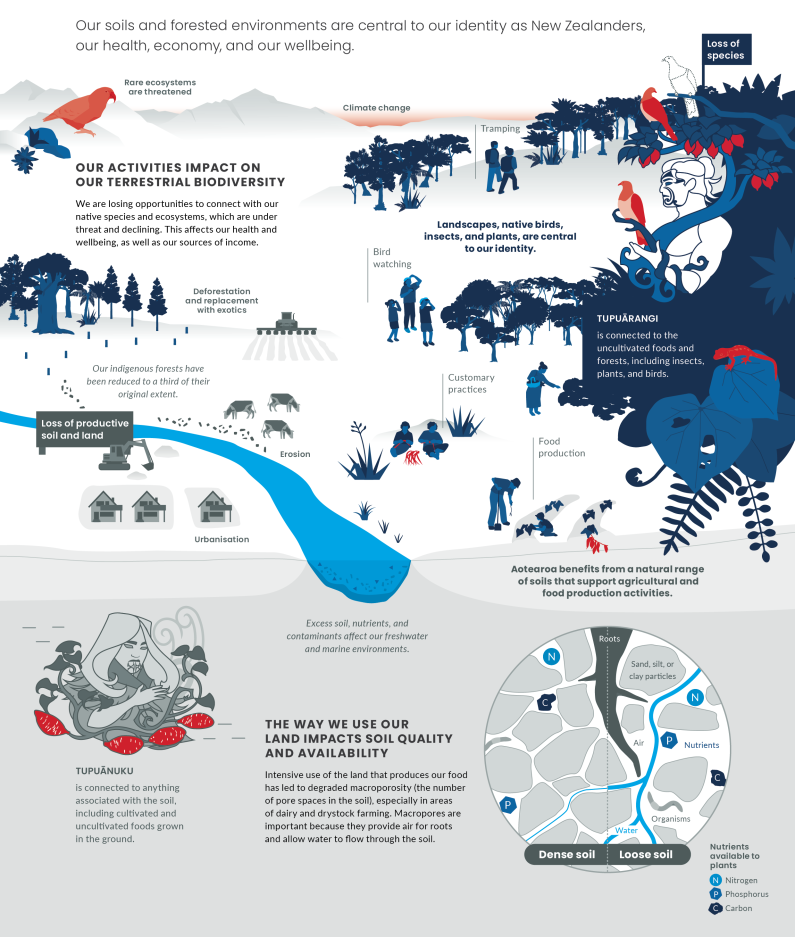Tupuānuku Our soils and food grown in the earth

E tū Tupuānuku e
Tiritiria te oneone
Kia matomato ki raro
Ka tīnaku, ka tupu, ka tāmaota ngā māra e
Behold Tupuānuku
Till the soil
So everything becomes lush
Germinate, grow, and let the gardens be abundant
Tupuānuku (Pleione) is the star connected to anything within the soil. This star also represents geographical features such as mountains, plains, and valleys. She is associated with the food grown in the ground, both cultivated (ie grown in gardens) and uncultivated. Tupuānuku is comprised of two words: ‘tupu’ which can mean ‘new shoot’ or ‘to grow’, and ‘nuku’, an abbreviation of ‘Papatūānuku’ (Earth mother). Tupuānuku resides in the domain of Rongo-mā-Tāne, the atua of agriculture.
This section is about the health of our soils and the different ways in which this affects our wellbeing.
Tāne (atua of the forest) created the first woman, Hineahuone, from clay (her name means ‘earth-formed woman’) (Hutchings et al, 2018). Her source (clay) highlights the importance of soil and the connection between soil and people. This connection is also seen in Māori language (te reo Māori), where the word ‘whenua’ means both ‘land’ and ‘placenta’. The whenua or placenta is often buried at a significant place such as a marae, acknowledging the intimate spiritual and physical connection between land and people (Harmsworth & Awatere, 2013).
For some Māori, soil health is reflected in its capacity as a living ecosystem to sustain and support all life, including microbes, plants, animals, and humans (Hutchings et al, 2018). Soil is the ancestor of our food (kai) and affects our wellbeing as consumers (Hutchings et al, 2020). This means soil requires special attention. Instead of viewing soil as a commodity, we can understand it as a living entity and enhance its mauri by protecting and growing its microbial diversity and structure (Hutchings et al, 2018) (see the Matariki section for the definition of mauri used in this report)
Dr Jessica Hutchings (Ngāi Tahu, Gujarati) is a Māori research leader and organic farmer who has helped shape a Māori framing of the soil. She notes that “When I hold soil or living compost in my hands, there’s a feeling of intrigue, of mystery, about its creative potential for growth and for nurturing ngā kākano (seeds) into life. I have reverence for soil because she is my tupuna and there is no separation between me as a human being and the soil as my ancestor.”
For Jessica, “Soil is the most precious thing we have. We come from soil and are the embodied form of Papatūānuku, so to assign personhood status and see soil as an ancestor would elevate her mana. Our soil is suffering, and time is running out – we need an intervention as bold as giving soils personhood status to change the way we think about soils and to restore their immeasurable value.”
For further discussion of Jessica’s work and her ideas for elevating the mana of soils, see Our land 2021.
Caring for the soils through land healing and regeneration practices contributes to restoring the biodiversity and mauri of whenua, ecosystems, and species (Hutchings et al, 2020). For some Māori, the indivisible connection between environmental and human health means the state of the soil affects our wellbeing (Harmsworth & Awatere, 2013).
From archaeology we have historic evidence that Māori gardeners adapted their practices to the specific features of the land and worked in harmony with environmental conditions (Furey, 2006). This reflects kaupapa Māori (a Māori way), so is similarly observed today in the whole-of-landscape Māori approach towards soil health which highlights the tikanga (customs/protocols) and associated gardening practices of growing food (kai) (Hutchings et al, 2018).
These practices seek to improve the mauri of the soil and include composting, using livestock to increase soil fertility, and reducing the use of mechanised equipment to limit soil compaction. Nitrogen-fixing crops are grown to add nutrients, help maintain soil structure, and prevent erosion. The whole-of-landscape Māori soil health approach also aims to maintain natural soil processes by avoiding the use of chemical fertilisers, pesticides, and herbicides (Hutchings et al, 2018). Long-established soil care practices that can adjust to natural variability continue to build knowledge and improve soil health, whilst also emphasising the whakapapa (genealogy) of the soils and encouraging resilient cultivation and sustainable use of soils in the future (Hutchings et al, 2018).
The greatest yields are when this knowledge is used together with the maramataka, which provides guidance on when to plant and harvest for the best results. Maramataka means ‘the moon turning’ and is the traditional Māori way by which time was marked by observing the phases of the moon. It is commonly held that Matariki and the maramataka both inform our understanding of how the various lunar nights affect the world and all its inhabitants. In turn, this understanding informs planning and day-today activities (Matamua, 2017). For example, according to horticulture and rongoā rākau (plant medicine) knowledge holder Joan Ropiha, planting kūmara during favourable phases of the moon means the crop will be resistant to decay once it is harvested and stored (Ropiha, 2010).
Some believe that if Tupuānuku appears dim and small when Matariki rises in the new year, it signals anticipation that the harvest from the gardens in the year to come would be less plentiful than previous harvests. If the star is bright in the sky, then storehouses would be full with a plentiful harvest (Matamua, 2017).
The connection between Tupuānuku and agriculture is reflected in the proverb (whakataukī) ‘Hauhake tū, ka tō Matariki’ (the harvest ends when Matariki sets). Traditionally, the harvesting of gardens is undertaken in autumn, during the month of Poutūterangi (around March and April). At this time of year Matariki sets in the western sky at dusk and does not appear again until winter, when it rises at dawn, marking the beginning of the Māori new year.
As we have seen, in the Māori worldview (te aō Māori), the state of the soil affects our wellbeing (Stronge et al, 2020). Initial international research also suggests soil health, food nutrition, and therefore human health, are linked – healthier soil means healthier food and so healthier people (Cirillo et al, 2016; Omondi et al, 2021; Ren et al, 2017). Many factors contribute to the uptake of nutrients from the soil by crops, and the relationship between soil quality and nutritional quality is not clearly understood. However, evidence shows that changes in soil fertility affect the nutrient content of fruits and vegetables (Meagy, 2014), and that crops grown with a focus on long-term soil management have greater nutritional value (Mitchell et al, 2007; Omondi et al, 2021; Ren et al, 2017).
Soil is the basis for our food production. Keeping soil healthy and productive ensures we can maintain its ability to produce food and fibre for our own use and export (MfE & Stats NZ, 2021a). Aotearoa soils also provide benefits beyond production, such as supplying building materials, the ability to filter nutrients and contaminants, the ability to store water and mitigate floods, decomposition of wastes, and maintaining biodiversity (Brevik et al, 2020; Dominati & Mackay, 2013). Healthy soils also support microorganisms that are important for human nutrition and developing our immune systems (Brevik et al, 2020). These benefits are lost if soils erode or are degraded.
Trade-offs are likely required as soils managed for agricultural benefit alone mean we lose some of the other benefits (Ng & Zhang, 2019). For example, the value of non-production benefits provided by soils decreases with higher stocking rates on a typical dairy farm in Aotearoa (Breure et al, 2012).
When measuring and managing soil health, a broad view of the benefits of healthy soil beyond increasing agricultural production can enhance our wellbeing in many ways: “A healthy soil determined purely on its ability to supply goods is equivalent to measuring human health based on a person’s ability to do work or a person’s economic value as a member of the society” (Ng & Zhang, 2019). Broadening the concept of soil health to wellbeing can help reflect the diverse societal and cultural values and help consider soil management in a more sustainable way (Stronge et al, 2020).
In addition to providing us with sustenance, food grown from the land, through agriculture and horticulture, contributes to the economy of Aotearoa. In the year ended March 2020, agriculture contributed 4.3 percent of GDP, equating to $14 billion. The respective contributions to this total were 50 percent from dairy, 28 percent from sheep and beef, and 17 percent from horticulture (Stats NZ, 2021a).
Agriculture comprises a significant share of export revenue: in 2020, agriculture and horticulture exports generated $40.7 billion in export revenue (MPI, 2021f). (Note, export revenue is not the same as economic benefit to Aotearoa.)
Māori own a significant proportion of assets in the primary sector: 30 percent of lamb production, 30 percent of sheep and beef production, 10 percent of dairy production, and 10 percent of kiwifruit production (MFAT, 2019). In 2012, about 6 percent of the total exports of Aotearoa came from the Māori economy, which encompasses all people, entities, and enterprises self-identifying as Māori. The main contributions to this were meat and dairy (Schulze & Reid, 2019).
As outlined above, specific soils and topographies are best suited to growing certain crops, and we know that repeated cropping on the same soils depletes their fertility. However, today, there are numerous pressures on our land, affecting soil quality and the extent of land suitable for growing food crops. Here we provide a high-level overview of soil quality; for more detailed information see Our land 2021. For more information on pressures on our land see the Pōhutukawa section.
Seven soil indicators are commonly used to monitor soil quality in Aotearoa. These are:
Intensive use of food-producing land can degrade soil health, which has flow-on effects on soil productivity. Heavy machinery and large numbers of livestock per hectare can cause damage by compacting the soil which has a negative effect on the macroporosity of the soil (Drewry et al, 2008; MfE & Stats NZ, 2021a). Pastures on degraded soils respond less to nitrogen fertilisers, while soil compaction can also increase nitrogen dioxide emissions (Douglas, 1994; Hu et al, 2021).
Soil compaction can also lower productivity. In Aotearoa, pasture production was estimated to decrease by an average of 2.5 percent for every 1 percent decrease in macroporosity within the first 10 centimetres of the soil layer (Hu et al, 2021).
The biodiversity of soil is not routinely monitored in Aotearoa, despite being an important measure of overall soil health. The concept of soil health is more holistic than soil quality, focusing on how soil functions as a living ecosystem. Soils are home to over 25 percent of the world’s total biodiversity (FAO et al, 2020), and contain insects, worms, fungi, and microorganisms. These have an important role making nutrients available for plants to grow and protecting them from disease (MfE & Stats NZ, 2021a). Understanding soil biodiversity and its effects on the wider environment remains a large knowledge gap in Aotearoa and globally.
Diversity of microorganisms in the soil is lower at sites with a history of nitrogen fertilisation and this may limit future restoration of soil ecosystems and habitats (Addison et al, 2021). Intensive agricultural land use can reduce the microbial biodiversity in soils for decades. This means those soils could be best suited for agriculture or plantation forestry, and have limited capacity to be restored to native ecosystems or to adapt to climate change effects (Addison et al, 2021).
There was no overall improving trend in soil quality observed over the period 1994–2018 in Aotearoa (Stevenson & McNeill, 2020). Sites measured comprised a range of land uses, including farming (dairy and drystock), horticulture, forestry, and lifestyle.
Eighty percent of measured sites failed to meet the targets for at least one of the seven soil quality indicators for the period 2014–18. Of note, nearly half of all sites (275 of 602) were below the target range for macroporosity, which indicates whether roots can access air and whether water can flow through the soil. This was especially notable in:
Over the period 2014–18, over 90 percent of measured sites met target ranges for the following soil quality indicators: bulk density, mineralisable nitrogen, total carbon, and pH (soil acidity). (See indicator: Soil quality and land use.)

Image: Data source — Manaaki Whenua – Landcare Research

Image: Data source — Manaaki Whenua – Landcare Research
Highly productive land (which makes up only 15 percent of our country’s total land area) is increasingly under pressure from the demand for more housing, especially around our cities (MfE & Stats NZ, 2021a) (see Pōhutukawa section.) The area of highly productive land no longer available for crops and livestock increased by 54 percent in the period 2002–19. (See indicator: Land fragmentation.)
Erosion is a widespread natural process in Aotearoa mainly due to weak and highly erodible rocks and high rainfall events. However, human actions have made large areas of land more susceptible to erosion, especially the deforestation of hill country for pastoral farming. As reported in Environment Aotearoa 2019, there is a knowledge gap on monitoring erosion and we have limited understanding of where, how, and to what extent it is happening. Data from 2012 showed that an estimated 192 million tonnes of eroded soil entered our rivers each year. Forty-four percent of this (84 million tonnes) was estimated to have come from land with exotic grass cover (including pastoral farmland). In decreasing order, West Coast, Gisborne, Otago, Canterbury, Northland, and Manawatū/Whanganui were the regions with the highest levels of sediment movement into waterways. (See indicators: Estimated long-term soil erosion, Highly erodible land.)
Small forested catchments with native or exotic forest cover tend to yield 50 to 80 percent less sediment than pastoral catchments, with variation due to rainfall, topography, and geology (Basher, 2013). However, the harvesting of plantation forests can lead to soils becoming vulnerable to erosion, particularly on erodible steep land (Phillips et al, 2017).
Losing soil through erosion reduces the benefits that soils can provide (Dominati & Mackay, 2013). Shallow landslides are one of the most widespread types of erosion in Aotearoa. These landslides remove soil nutrients and reduce its depth and water holding capacity (Basher, 2013). Eroded soils often have limited biodiversity (Rey, 2021). Soil washed from the land can degrade freshwater habitats by filling in streambeds that fish and invertebrates use to hide and breed, while making it more difficult for them to find food (MfE & Stats NZ, 2020b). Fine sedimentation can also increase flooding, disrupt the functioning of hydroelectric power dams, and make rivers less suitable for recreation and traditional food gathering practices (mahinga kai) (Collier et al, 2017; Rey, 2021). (See indicator: Deposited sediment in rivers.)
Soil loss can be prevented. Vegetation on sloping land helps to slow run-off and reduce erosion, and vegetation on riverbanks helps control water currents, protecting banks from erosion (Rey, 2021). Low-density shrubland reforestation such as with mānuka can help reduce erosion in steep areas, especially where root structures reach beyond the depth where landslides occur. Increased planting density and improved weed management for seedling success could further mitigate erosion (Marden et al, 2020).
The quality of our soils is not always within target ranges. Eighty percent of measured sites did not meet soil quality targets for at least one indicator for 2014–18, with nearly half of all sites below the target range for macroporosity. We also continue to lose our productive soils to erosion, development, and land fragmentation.
If this continues we risk our current food production systems becoming unsustainable. The variety, quality, and amount of food we can grow could be limited, compromising the ability to access the food we need and reducing the economic benefits from our primary sector. How we look after our soil has wide-ranging consequences for both our health and the environment, including nutrients and sediment in rivers and estuaries. (See the Waitī and Waitā sections for more detail.)

Tupuānuku is connected to anything associated with the soil, including cultivated and uncultivated foods grown in the ground.
Tupuārangi is connected to the uncultivated foods and forests, including insets, plants, and birds.
Our soils and forested environments are central to our identity as New Zealanders, our health, economy, and our wellbeing.
Our activities impact on our terrestrial biodiversity: We are losing opportunities to connect with our native species and ecosystems, which are under threat and declining. This affects our health and wellbeing, as well as our sources of income.
The way we use our land impacts soil quality and availability: Intensive use of the land that produces our food has led to degraded microporosity (the number of pore spaces in the soil), especially in areas of dairy and drystock farming. Macropores are important because they provide air for roots and allow water to flow through the soil.

Tupuānuku is connected to anything associated with the soil, including cultivated and uncultivated foods grown in the ground.
Tupuārangi is connected to the uncultivated foods and forests, including insets, plants, and birds.
Our soils and forested environments are central to our identity as New Zealanders, our health, economy, and our wellbeing.
Our activities impact on our terrestrial biodiversity: We are losing opportunities to connect with our native species and ecosystems, which are under threat and declining. This affects our health and wellbeing, as well as our sources of income.
The way we use our land impacts soil quality and availability: Intensive use of the land that produces our food has led to degraded microporosity (the number of pore spaces in the soil), especially in areas of dairy and drystock farming. Macropores are important because they provide air for roots and allow water to flow through the soil.

Tupuānuku Our soils and food grown in the earth
April 2022
© Ministry for the Environment